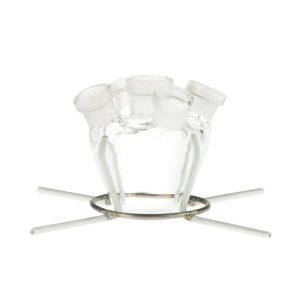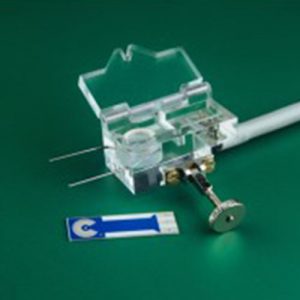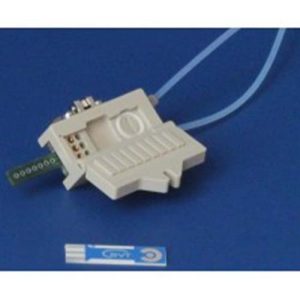.
BVT-AC1 Electrochemical Sensor
The sensor is formed on a corundum ceramic base. On this surface the working, the reference and the counter electrodes are applied. The working and the counter electrodes can be made of variety of materials. A bio-chemically active substance can be immobilized on the working electrode of the sensor to create a biosensor.
Working and Counter electrode
- W1 Gold
- W2 Platinum
- W3 Silver
- W4 Carbon
- WS Gold Platinum-alloy
Note for Gold electrodes: The SPEs do not have homogenous properties during print. Each production batch is grouped in boxes, where the SPEs with the same properties are in one box.
The reference electrode
- R1 Ag / AgCl mixed – a nice basic reference electrode
- R2 Ag covered with AgCl – shows a higher stability. Suitable for most organic solvents.
- RS Ag – these give a stable potential in chloride solution but can also be used a pseudo reference electrode
Working electrode diameter
- 1mm Standard diameter
- 2mm Larger working electrode (for carbon electrodes this will result in 2.4 ±0.1 mm)
Electrode naming pattern
- The electrodes are named in the pattern AC1.Wn.Rm with n and m being 1, 2, 3, 4 or S.
Dimensions
- 25.4 x 7.26 x 0.63 mm.
More information is available in the specifications tab or at the product’s website.

BVT-AC1 Electrochemical Sensor
Features
- Three-electrode system
- Thick-film technology
- Same material for working and counter electrode
Specifications
| WE material | Carbon, Gold, Platinum, Platinum Gold Alloy, Silver |
|---|---|
| RE material | Silver, Silver and Silver Chloride Mixed, Silver covered with Silver Chloride |
| WE size | 1 mm (default), 2 mm, 4 mm |
| Surface modification | Blank |
| Brand | BVT Technologies |
| Amount of WEs | 1 |
| CE material | Carbon, Gold |
| Electrode system | CE + RE+ WE |
| Combined RE and CE | No |
| Ø of the disc WE / mm | 1, 2 |
| Support material | Alumina Ceramic |
| Support dimensions / mm | 7 by 25 |
| Possible analytes | Various |
| Possible applications | Various |
Manufacturers
show DATA — DO NOT CHANGE ID–
Industries
show DATA — DO NOT CHANGE ID–





